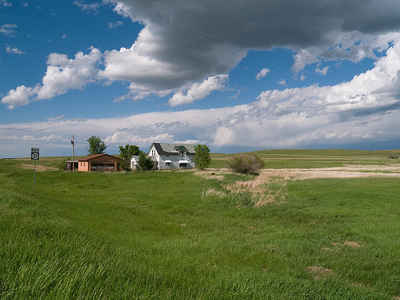North Dakota State Fruit
Chokecherry
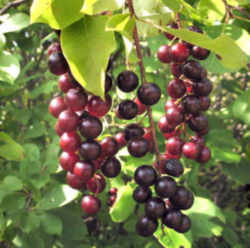
(Prunus virginiana)
Adopted on March 29, 2007.
In 2007, the Legislative Assembly made the chokecherry the official state fruit of North Dakota. The chokecherry grows wild in all parts of North Dakota. The dark-red berry is a popular fruit for making jelly, syrup, and wine. The chokecherry is also an important food for birds and other wildlife. The idea of naming the chokecherry the official state fruit came from Williston elementary students.
North Dakota State Fruit: Chokecherry
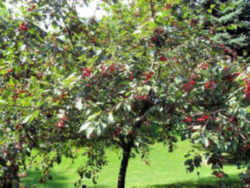
Prunus virginiana, commonly called bitter-berry, chokecherry, Virginia bird cherry and western chokecherry (also black chokecherry for P. virginiana var. demissa), is a species of bird cherry (Prunus subgenus Padus) native to North America; the natural historic range of P. virginiana includes most of the continent, except for the far north and far south.
Chokecherry is a suckering shrub or small tree growing to 16 feet tall. The leaves are oval, 1.25-4 in. long, with a coarsely serrated margin. The flowers are produced in racemes of 15-30 in late spring (well after leaf emergence). The fruit are about .4 inch diameter, range in color from bright red to black, with a very astringent taste, being both somewhat sour and somewhat bitter. The very ripe berries are dark in color and less astringent and more sweet than the red berries.
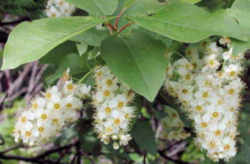
The Common Chokecherry is a small tree, sometimes a shrub, and often it forms dense thickets of woody growth. The bark of the tree is brown or gray, sometimes smooth, sometimes scaly. The Common Chokecherry grows commonly in rich moist soils, but often is found in poorer, drier soils. It grows in forest edges and openings, and often is found in uncultivated edges and corners of farmland. The natural range of this tree includes much of southern Canada and northern United States. In Ohio it occurs most frequently in the northern counties and in scattered parts of the southern counties. The wood of this tree is similar to that of the Black Cherry, but it has no commercial value because of the tree's small size. Many kinds of wildlife eat its small fruits. Although the fruit is harsh and puckery, people sometimes use it in making jellies. People also occasionally plant the Common Chokecherry tree as an ornamental, or to provide food for birds.
Chokecherry lobbying bears fruit
March 29, 2007 7:00 pm • JONATHAN RIVOLI Bismarck Tribune
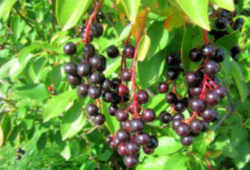 Surrounded by a throng of smiling
seventh-graders, Gov. John Hoeven signed legislation Thursday designating the chokecherry as North Dakota's state fruit.
Surrounded by a throng of smiling
seventh-graders, Gov. John Hoeven signed legislation Thursday designating the chokecherry as North Dakota's state fruit.
"It's now official," Hoeven said as he signed the bill. The seventh-graders smiled and clapped.
It was a big day for them. Starting last winter, when they were sixth-graders at Rickard Elementary School in Williston, these students became the
driving force behind North Dakota's adoption of an official state fruit. They were soon dubbed the "berry bunch."
The fruit they advocated, the chokecherry, is a small berry that has a long history of use in jams, syrups and wine. Growing wild on medium-sized bushes,
the chokecherry is native to North America from Western Canada to New Mexico, including in North Dakota.
It joins a long list of official state symbols, which includes milk as the official state beverage, the northern pike as the official state fish, wild
prairie rose as the official state flower and square dancing as the official state dance.
The effort to add the chokecherry to this list began with an innocent question from a few of the sixth-graders to their teacher: Why doesn't North
Dakota have an official state fruit?
Teacher Nancy Selby urged her students to research the topic. It just so happened that, at the same time, the students were learning to write persuasive
letters in the English portion of their curriculum. Many decided to write letters to Hoeven asking him about a state fruit.
Hoeven, noting that governor can't just declare state symbols by fiat, referred to them to their local legislator, Sen. Stanly Lyson, R-Williston.
Lyson quickly got back to the kids, asking them to come back to him after they'd done their research on the chokecherry and other potential state fruits.
And that's when the real work began.
Dividing into teams, the students began researching the topic.
"We spent a lot of time in the computer lab in our school finding out anything we could about it," said class member Ali Brurud, 13.
Ali estimates she spent nearly 20 hours working on various stages of the chokecherry bunch.
Josten Bratcher, 12, said the students accomplished this large task by dividing up the labor and working together.
"It was all about teamwork," Jason said.
While doing their research, the students also considered the buffalo berry and the black cherry.
But the chokecherry won out because the students found that it was used by American Indians on the Great Plains and by Lewis and Clark on their famous
transcontinental journey.
"It was the one we found to be most native," said class member Amanda Suess, 12.
In addition to research, the students engaged in a letter-writing campaign to their legislators. They also wrote letters to other North Dakota schools,
asking kids there to contact their own legislators to make a case for the chokecherry.
With their letter-writing campaign well under way, the students came to the Capitol earlier this year to testify during a legislative hearing on designating
the chokecherry as the official state fruit. Their idea won by wide margins in both the state House and state Senate.
"The energy of these kids really pulled it through," said Selby, their teacher.
Selby said the project taught her students that they can make a real difference in their government. It also taught them the importance of doing thorough
research and backing up their suggestions with facts.
As Thursday's signing concluded, a jovial Hoeven congratulated the kids on their efforts and posed for pictures with them. He soon ditched his suit
jacket in favor of a white T-shirt that the kids presented to him.
In bright red letters on the back it said: "I'm a chokecherry kid."
North Dakota Law
The law designating the chokeberry as the official North Dakota state fruit is found in the North Dakota Revised Statutes, Title 54, Chapter 54-02, Section 54-02-17.
TITLE 54 STATE GOVERNMENT.
CHAPTER 54-02 STATE EMBLEMS, SYMBOLS, AND AWARDS
SECTION 54-02-17
54-02-17. State fruit. The chokecherry, Prunus virginiana, is the official fruit of the state of North Dakota.
Taxonomic Hierarchy: Chokeberry
Kingdom: Plantae - Plants
Subkingdom: Tracheobionta - Vascular plants
Superdivision: Spermatophyta - Seed plants
Division: Magnoliophyta - Flowering plants
Class: Magnoliopsida - Dicotyledons
Subclass: Rosidae
Order: Rosales
Family: Rosaceae - Rose family
Genus: Prunus L. - plum
Species: Prunus virginiana L. - chokecherry

List Official US State Foods




